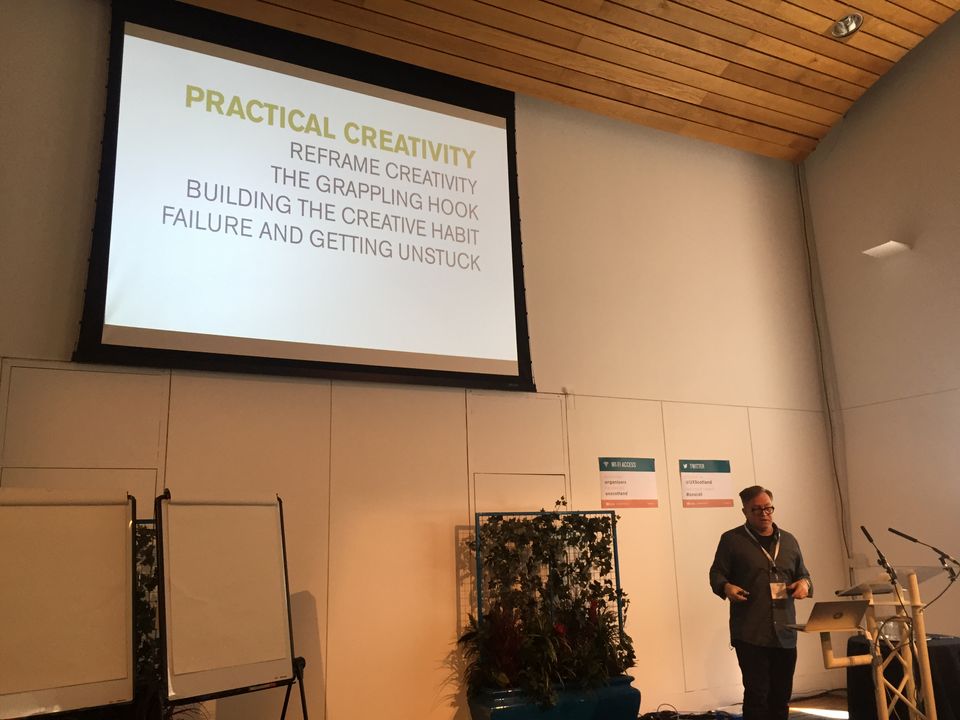Practical Creativity

Dan Saffer hates the job title “creative”. To him, it evokes images of dancers, poets, artists … people who do wildly imaginative things far beyond the remit of a design brief. Yet it’s something that as designers we take on at times without much consideration. We’re expected to be able to pull the rabbit out of the hat, and be creative at a moment’s notice.
Funnily enough, some of the great designers don’t think that being a designer is about creativity. Pentagram partner Michael Bierut suggests that it’s really about imagination and knowledge. Still, we need to be able to draw from a personal resources of ‘practical creativity’.
Saffer spoke of the need to consider ideas as needing both a line and a hook. Without a hook (think the hook of a song) it’s rudderless; without a line it’s just decoration.
A overwhelming metaphor that came out of his talk was the idea of creativity as a well. You need to prepare to fill the well – create rituals for getting into being creative, be it getting up at 4am and going to the gym or just making a cup of tea, and give yourself plenty of time to be able to push the idea round.
You need to put ideas and inspiration into the well – interesting, high quality inspiration “you should be reading fiction rather than just trawling design sites”, having numerous notebooks that you can jot down your ideas.
You need to allow time for stillness, be it through going for a walk (proven to help with creativity), having a shower, or meditating, and generally putting down the phone. Saffer has a digital sabbatical and shabbot – Saturdays with no screens and twice yearly a week away from them (usually carefully timed around holidays so work isn’t affected). More than anything, you have to be OK with being alone – which a lot of people aren’t, proven by scientific studies and mused about by comedians.
You need to also commit to regularly tending your creative well: “it’s better to regularly block out an hour to do it rather than an occasional big block of time … as someone will see that block and book a meeting”.
He also noted a few things from his experiences:
- When things go wrong, you should remember that you’re working on a body of work – you are more than just that latest product that got bad feedback on twitter.
- Have side projects. Making a texting teapot is something that’s only yours.
- Be just a little more courageous. Just a bit. Say 10%. (Or for Brits, what, say an American or Antipodean would be like).
- Ask for help if you’re stuck. It’s OK not to be able to do everything, it’s not that you can’t do it, you just can’t do it … yet. (For the record, he mentioned … that thing about failing being good? Never said by someone who actually failed. Real failure is horrible, soul destroying, possibly credit card score destroying too.)
He finished with a call about the future. When advising his 14 year old daughter about career options, he told her to not be safe – as those safe jobs will be the ones that disappear to robots (or outsourcing).
Be weird, be unusual, be creative, that’s what will save you. – Dan Saffer
As an aside, I think that Saffer made an important point that many of us don’t necessarily realise – when we look at the amazing output a particular person may have, that person themselves may look at that time and think the exact same thing. Saffer’s creating of means to enable practical creativity came about during a period of creative burnout … and he looked at his own prodigious output a few years before (books, several talks etc) and wonder “how did *I* do all of that?”
If there’s anything I’d be more interested in, it’s the action-reflection part of it – namely how you remember to look at what is in your notebooks and the like. Saffer uses his yearly links roundups as a way of consolidating what he’s seen, but admits that he doesn’t do the reviewing as much as he should. He does know of one person who reviews weekly, but doesn’t have the discipline for it himself (and I know that I wouldn’t). Lauren Currie suggested tools such as the Johari Window and the Hyper Island toolbox.
An earlier version of his talk is available online and below.
I also interviewed him in the leadup to UX Scotland.
Member discussion